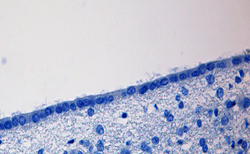Ependymal cell
| Ependyma | |
|---|---|

Section of central canal of the spinal cord, showing ependymal and neuroglial cells
|
|

Photomicrograph of normal ependymal cells at 400× magnification in human autopsy tissue
|
|
| Identifiers | |
| MeSH | A08.186.211.276.460 |
| TA | A14.1.00.022 |
|
Anatomical terminology
[]
|
|
Ependyma is the thin epithelial lining of the ventricular system of the brain and the central canal of the spinal cord, made up of ependymal cells. Ependyma is one of the four types of neuroglia in the central nervous system (CNS). It is involved in the production of cerebrospinal fluid (CSF), and is shown to serve as a reservoir for neuroregeneration.
The ependyma is made up of ependymal cells called ependymocytes, a type of glial cell. These cells line the CSF-filled ventricles in the brain and the central canal of the spinal cord. These are nervous tissue cells with a ciliated simple columnar form much like that of some mucosal epithelial cells.
The basal membranes of these cells are characterized by tentacle-like extensions that attach to astrocytes.
Lining the CSF-filled ventricles, the ependymal cells play an important role in the production and regulation of CSF. Their apical surfaces are covered in a layer of cilia, which circulate CSF around the CNS. Their apical surfaces are also covered with microvilli, which absorb CSF. Within the ventricles of the brain, a population of modified ependymal cells and capillaries together form a system called the choroid plexus, which produces the CSF.
Modified tight junctions between epithelial cells control fluid release. This release allows free exchange between CSF and nervous tissue of brain and spinal cord, which is why sampling of CSF (e.g. through a "spinal tap") provides a window to the CNS.
...
Wikipedia
